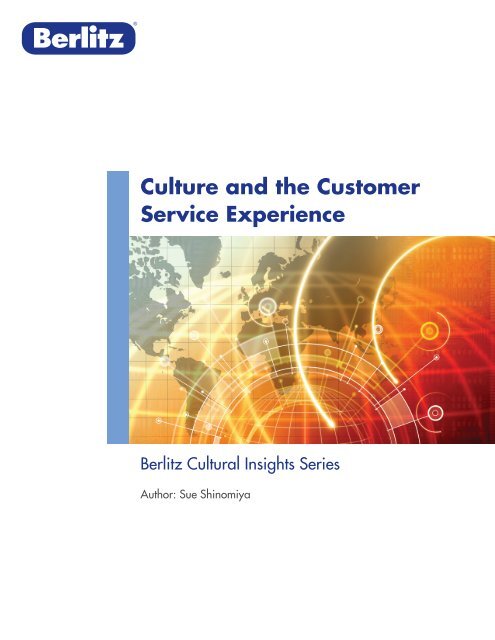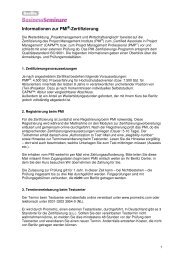Culture and the Customer Service Experience - Berlitz
Culture and the Customer Service Experience - Berlitz
Culture and the Customer Service Experience - Berlitz
Create successful ePaper yourself
Turn your PDF publications into a flip-book with our unique Google optimized e-Paper software.
<strong>Culture</strong> <strong>and</strong> <strong>the</strong> <strong>Customer</strong><br />
<strong>Service</strong> <strong>Experience</strong><br />
<strong>Berlitz</strong> Cultural Insights Series<br />
Author: Sue Shinomiya
Some 64% of consumers<br />
said <strong>the</strong>y switched from one<br />
service provider to a new<br />
one in 2010. That’s up from<br />
a low of 49% in 2005.<br />
American Express Global<br />
<strong>Service</strong> Barometer Survey,<br />
July 2010<br />
“Word of mouth has<br />
always been an important<br />
motivator for consumers,<br />
but it’s been thrust into<br />
new levels of importance<br />
as social networking<br />
proliferates,” Robert<br />
Wollan, global managing<br />
director of Accenture’s<br />
customer relationship<br />
management practice.<br />
<strong>Culture</strong> <strong>and</strong> <strong>the</strong> <strong>Customer</strong><br />
<strong>Service</strong> <strong>Experience</strong><br />
The Global Business L<strong>and</strong>scape<br />
<strong>Berlitz</strong> Cultural Insights Series<br />
Advances in technology enable us to communicate, collaborate <strong>and</strong> provide services<br />
instantaneously 24/7 with co-workers <strong>and</strong> customers in almost any part of <strong>the</strong> world.<br />
But do we have <strong>the</strong> cultural skill set <strong>and</strong> know-how to be truly productive in a global<br />
marketplace, provide <strong>the</strong> best customer service, <strong>and</strong> make <strong>the</strong> most of <strong>the</strong> technology<br />
that connects us?<br />
<strong>Customer</strong>s typically expect quick, polite <strong>and</strong> thorough solutions. Assumptions about how<br />
to provide that excellent customer service experience, however, vary from culture to culture<br />
<strong>and</strong> often pose a challenge.<br />
For example, a key ingredient of quality customer service is “empathy” <strong>the</strong> identification<br />
with <strong>and</strong> underst<strong>and</strong>ing of ano<strong>the</strong>r’s situation, feelings <strong>and</strong> motives. But, is it possible for<br />
someone sitting in a call center in Eastern Europe, to really put <strong>the</strong>mselves in <strong>the</strong> customer’s<br />
shoes in Canada?<br />
Underst<strong>and</strong>ing cultural values, behaviors <strong>and</strong> attitudes regarding service expectations <strong>and</strong><br />
a working knowledge of social protocol <strong>and</strong> etiquette in various cultures is essential for<br />
success today. Organizations that focus on customer service require a global perspective<br />
in <strong>the</strong>ir approach.<br />
Global Satisfaction Trends<br />
Three overarching trends are driving new approaches to global customer<br />
service, according to <strong>the</strong> 2010 Global Trends report.<br />
1. Social media, collaboration tools <strong>and</strong> technology connecting people around<br />
<strong>the</strong> globe, require new strategies, skill sets <strong>and</strong> mindsets <strong>and</strong> bring new pressure on<br />
companies to be more mindful of <strong>the</strong>ir customer service.<br />
A bad experience can lead to a quick blog or tweet, <strong>and</strong> can result in damage to <strong>the</strong><br />
company’s image. It is much less expensive to deal with a routine customer complaint in<br />
a way that gives <strong>the</strong>m a good experience than it is to lose a good customer.<br />
2. Emerging new markets, including some of <strong>the</strong> fastest growing economies such as<br />
Ghana, Qatar, Turkmenistan <strong>and</strong> China, will provide <strong>the</strong> consumer growth engines of<br />
<strong>the</strong> future.<br />
3. Globalization of <strong>the</strong> labor market will drive companies to compete for <strong>the</strong><br />
same global brainpower <strong>and</strong> talent. Off-shoring <strong>and</strong> outsourcing are not just ways to<br />
save money, <strong>the</strong>y are essential strategies to compete in <strong>the</strong> global marketplace.<br />
<strong>Culture</strong> <strong>and</strong> <strong>the</strong> <strong>Customer</strong> <strong>Service</strong> <strong>Experience</strong> 2
The Global <strong>Customer</strong> <strong>Service</strong> <strong>Experience</strong> Dilemma<br />
<strong>Berlitz</strong> Cultural Insights Series<br />
<strong>Customer</strong> service surveys conducted worldwide indicate <strong>the</strong>re may be some<br />
universal expectations for service providers which are:<br />
n Is available in a timely manner<br />
n Is competent, knows <strong>the</strong> product, knows <strong>the</strong> customers<br />
n Is courteous<br />
n Creates a positive “customer experience”<br />
While it may seem obvious that consumers want courteous, competent treatment, words<br />
like “timely”, “competent” <strong>and</strong> “courteous” are subject to cultural, regional <strong>and</strong> o<strong>the</strong>r<br />
personal interpretations.<br />
For example, a customer in <strong>the</strong> U.S. might be impressed with a representative who takes<br />
control of <strong>the</strong> situation, conveys <strong>the</strong> confidence that “I can get <strong>the</strong> job done for you”,<br />
chats with <strong>the</strong> customer, gives him or her recommended choices, <strong>and</strong> maybe even throws<br />
in a joke while <strong>the</strong> issue is being resolved or <strong>the</strong> service is being rendered.<br />
This would probably not impress a Japanese customer, who is used to a representative who<br />
speaks softly or in a higher-pitched tone, <strong>and</strong> uses honorifics <strong>and</strong> polite phrases to show<br />
respect for <strong>the</strong> customer by being humble.<br />
A Sc<strong>and</strong>inavian might prefer a straight-forward manner–service without a smile–<strong>and</strong> would<br />
feel that anything but <strong>the</strong> transaction would be excessive <strong>and</strong> too much like a hard sell.<br />
From a business perspective, it is vital that <strong>the</strong> service provider accepts <strong>the</strong> responsibility to<br />
adapt as much as possible to <strong>the</strong> culture of <strong>the</strong> customer. <strong>Customer</strong>s adapt by moving to a<br />
provider that better meets <strong>the</strong>ir expectations!<br />
A positive customer service experience differs<br />
from culture to culture<br />
“ I am sorry to have kept you<br />
waiting. You are very welcome<br />
here. The total is 4,757 yen. I<br />
humbly request 4,757 yen.<br />
I have certainly just received<br />
10,000 yen. Shall I take it from<br />
10,000 yen? Your change is<br />
5,243 yen. I will first give you<br />
<strong>the</strong> large bills. Please confirm.<br />
Here is your (small) change <strong>and</strong><br />
receipt. Please confirm. Thank<br />
you very much.”<br />
Photo source: R. Mastron<br />
“ Hi, I’m Hea<strong>the</strong>r, <strong>and</strong> it’s my<br />
pleasure to be your server tonight.<br />
We have some really great<br />
specials I’d like to tell you about.<br />
They’re all delicious, but my<br />
personal favorite is <strong>the</strong> shrimp<br />
fajitas seasoned with cilantro <strong>and</strong><br />
epazote; <strong>the</strong>y are just fabulous!”<br />
<strong>Culture</strong> <strong>and</strong> <strong>the</strong> <strong>Customer</strong> <strong>Service</strong> <strong>Experience</strong> 3
When an American agent<br />
answers a customer service<br />
call, <strong>the</strong> cost is approximately<br />
$7.50 per call. Outsourcing<br />
to live agents in ano<strong>the</strong>r<br />
country brings <strong>the</strong> average<br />
down to $2.35 a call. Having<br />
customers take care of <strong>the</strong><br />
problem <strong>the</strong>mselves through<br />
automated response or<br />
website averages around<br />
35 cents a call or contact.<br />
Connecting with culture to solve <strong>the</strong> problem:<br />
One example<br />
<strong>Berlitz</strong> Cultural Insights Series<br />
A customer’s “natural” preference is for local service <strong>and</strong> <strong>the</strong>y may be more willing to<br />
pay extra for local help. For example, <strong>the</strong> Apple ® iPad has a special $99 package that<br />
guarantees every time <strong>the</strong> customer calls <strong>the</strong> help desk, <strong>the</strong> person picking up <strong>the</strong> phone<br />
will be a U.S. American. Yet, many companies are offshoring or considering contact centers<br />
overseas to save money.<br />
One American IT <strong>Service</strong>s company decided to locate <strong>the</strong>ir global customer contact<br />
center in Sophia, Bulgaria, based on <strong>the</strong>ir underst<strong>and</strong>ing that Bulgaria is home to many<br />
sophisticated, educated young people with excellent technical skills, who are also<br />
conversant in <strong>the</strong> English language.<br />
Beyond <strong>the</strong> usual customer service training, <strong>the</strong>y offered English Language Pronunciation<br />
Training, but came to realize that <strong>the</strong> Bulgarians also needed a higher level of underst<strong>and</strong>ing<br />
of <strong>the</strong>ir customer’s actual business environment <strong>and</strong> cultural assumptions.<br />
<strong>Berlitz</strong> was brought in to help. They found service representatives were very competent at<br />
solving customer issues, but <strong>the</strong>re was a gap when it came to connecting with <strong>the</strong> customer<br />
<strong>and</strong> empathizing with <strong>the</strong>ir immediate situation.<br />
A custom course was designed to help contact center representatives better underst<strong>and</strong><br />
<strong>the</strong> cultural implications of <strong>the</strong>ir work <strong>and</strong> boost <strong>the</strong>ir confidence level. The response from<br />
<strong>the</strong> service agents has been quite positive, many of <strong>the</strong>m reporting new “Best Practices” in<br />
customer service that include <strong>the</strong> missing elements of connecting <strong>and</strong> empathizing with <strong>the</strong><br />
customer from <strong>the</strong> customer’s cultural point of view.<br />
Best Practices – especially for off-shoring <strong>and</strong> outsourcing<br />
Some tips for providing excellent global customer service:<br />
n Evaluate <strong>the</strong> regions where you will be providing customer service or if you have<br />
a contact center, <strong>the</strong> culture of that region. Analyze:<br />
• The historical perspective; is or was <strong>the</strong> area a capitalist or socialist society?<br />
How long has <strong>the</strong> culture experienced consumerism?<br />
In some cultures, <strong>the</strong> customer is always right. In countries where consumerism<br />
has a strong foothold, customers have power <strong>and</strong> expect to be catered to.<br />
In o<strong>the</strong>r countries, such as in Eastern Europe, where consumerism is not strong,<br />
customers are expected to wait in line <strong>and</strong> not make as strong dem<strong>and</strong>s.<br />
Consumerism may be seen less positively, while in o<strong>the</strong>r cultures <strong>the</strong> expectation<br />
is that if you work hard you get rewarded.<br />
In India, <strong>the</strong> “service sense” is very different. Transactions are a “dance” often<br />
involving bargaining <strong>and</strong> negotiation <strong>and</strong> may even get emotional.<br />
In addition, cultural differences may define our attitudes toward work entirely.<br />
Some cultures live to work while o<strong>the</strong>rs work to live.<br />
<strong>Culture</strong> <strong>and</strong> <strong>the</strong> <strong>Customer</strong> <strong>Service</strong> <strong>Experience</strong> 4
“ The most satisfied customers<br />
go out of <strong>the</strong>ir way to<br />
actively try to convince<br />
o<strong>the</strong>rs to do business<br />
with you. Unfortunately,<br />
dissatisfied customers<br />
make it a point to tell<br />
o<strong>the</strong>rs to stay away, <strong>and</strong><br />
dissatisfied customers are<br />
significantly more vocal.”<br />
JD Power <strong>and</strong> Associates<br />
• Time orientation: how long is a pause? Is it 3 seconds or 3 minutes?<br />
<strong>Berlitz</strong> Cultural Insights Series<br />
Research shows that pauses in 10 or 30 second intervals are acceptable in<br />
Eastern Europe. In some Asian cultures pauses lasting up to 1 minute are not<br />
unusual. In <strong>the</strong> Americas a pause that extends beyond 3.5 seconds is painful<br />
<strong>and</strong> Americans try to fill that void with a conversation even if it is “chit chat”.<br />
<strong>Culture</strong>s who are used to a longer pause may think this is a sign of disrespect<br />
or find it unusual to carry on a conversation outside <strong>the</strong> transaction itself.<br />
In <strong>the</strong> U.S., if a customer service representative is on <strong>the</strong> phone <strong>and</strong> needs to<br />
put a customer on hold, it is recommended <strong>the</strong>y tell <strong>the</strong> customer <strong>the</strong>y need to<br />
put <strong>the</strong>m on hold <strong>and</strong> ask if that is okay. In Eastern Europe, a much more<br />
transactional culture, representatives typically don’t ask permission.<br />
Asians on <strong>the</strong> o<strong>the</strong>r h<strong>and</strong>, apologize for putting a customer on hold, but don’t<br />
ask if that is okay.<br />
Underst<strong>and</strong>ing <strong>the</strong> time orientation of <strong>the</strong> culture is important.<br />
• Relationship vs. task orientation: Get it done, with or without a smile.<br />
In <strong>the</strong> United States, a customer service representative may appear to be <strong>the</strong><br />
customer’s “best friend” for five minutes. While <strong>the</strong>y are moving towards<br />
accomplishing <strong>the</strong> service task, <strong>the</strong>y are expected to appear personable<br />
<strong>and</strong> friendly.<br />
This approach is seen by many Eastern Europeans as ingenuine.<br />
In Asia, a slight, polite smile is expected, but Asians would not expect <strong>the</strong><br />
representative to act like <strong>the</strong>y are <strong>the</strong> customer’s best friend.<br />
• Achievement/optimism vs. Being/realism: What does “success”<br />
mean to your customers?<br />
In some cultures providing a business service to a customer is seen as an<br />
extension of <strong>the</strong> customer’s business—a “if you succeed we succeed mentality”.<br />
There is a “can do” attitude that is expected; let’s work as a team <strong>and</strong> solve<br />
it toge<strong>the</strong>r—as partners. <strong>Service</strong> representatives are expected to feel connected<br />
to <strong>the</strong> achievement of solving a problem.<br />
In Europe, where <strong>the</strong>re is a more “realistic” approach, customer service<br />
representatives expect to help solve <strong>the</strong> problem <strong>and</strong> move on. In cultures<br />
where <strong>the</strong>re is more “realism” representatives simply ask you about your problem<br />
<strong>and</strong> tell you “here is what you need to do to solve your problem”.<br />
In Asia, representatives show strong personal responsibility for a customer’s<br />
problem <strong>and</strong> would not expect <strong>the</strong> customer to be part of <strong>the</strong> resolution.<br />
• Formality vs. Friendliness: From “Yes, sir” to “How’s it going?”<br />
The level of formality vs. friendliness varies from country to country <strong>and</strong> culture<br />
to culture. For example:<br />
n In <strong>the</strong> U.S., it is not unusual for a customer service representative or sales<br />
person in a store to ask “How are you? Are you finding everything ok?<br />
Or “Did you find what you were looking for?”<br />
<strong>Culture</strong> <strong>and</strong> <strong>the</strong> <strong>Customer</strong> <strong>Service</strong> <strong>Experience</strong> 5
n This would not play as well in Engl<strong>and</strong> or Scotl<strong>and</strong> where consumers<br />
do not expect to be approached without prompting.<br />
<strong>Berlitz</strong> Cultural Insights Series<br />
n In Asia, representatives would greet customers <strong>and</strong> <strong>the</strong>n back off. There<br />
is a certain “distance” in some cultures which o<strong>the</strong>rs may perceive<br />
as “stiffness”.<br />
n Nor<strong>the</strong>rn Europeans are more formal <strong>and</strong> <strong>the</strong> transaction itself is important,<br />
not service with a smile. Just providing <strong>the</strong> service is enough.<br />
n Asians also treat <strong>the</strong>ir customers with more formality.<br />
• Directness vs. indirectness: “The problem is operator error” or<br />
“Many people have experienced this”<br />
Many countries such as Germany, Russia, Israel <strong>and</strong> Nor<strong>the</strong>rn European<br />
countries use a much more direct approach to help customers. Language used<br />
may include “This is where you went wrong,” or “ Your idea is off track.”<br />
North Americans may be much less direct <strong>and</strong> package <strong>the</strong>ir responses with<br />
temperance <strong>and</strong> words that validate <strong>the</strong> o<strong>the</strong>r person. Examples include<br />
“Let’s try this solution,” or “Let’s try it this way.”<br />
Issues are resolved differently in cultures where <strong>the</strong>re is individual accountability<br />
vs. where <strong>the</strong>re is group accountability such as in Japan. In Japan an issue may<br />
be resolved by going to a supervisor, consulting peers, or even bring in a third<br />
party as all parties are involved toge<strong>the</strong>r.<br />
• Hierarchical vs. egalitarian: “The customer is King”, or “I am an extension<br />
of your business”<br />
In some cultures, <strong>the</strong>y “partner” with customers putting <strong>the</strong>m on an equal footing.<br />
In addition, representatives avoid <strong>the</strong> word “problem” <strong>and</strong> use words like “issue”<br />
or “challenge” instead.<br />
This may be seen as impolite or disrespectful by o<strong>the</strong>r cultures. In Japan, for<br />
example, customers are treated “politely” <strong>and</strong> customers are put more on a<br />
pedestal than treated equally.<br />
<strong>Customer</strong> service representatives need to be trained to underst<strong>and</strong> <strong>and</strong> adapt to<br />
<strong>the</strong> cultural orientations of <strong>the</strong>ir customers.<br />
n Allow for pride in one’s own country’s achievements, history <strong>and</strong> culture <strong>and</strong> a<br />
balanced underst<strong>and</strong>ing of both <strong>the</strong> good <strong>and</strong> <strong>the</strong> bad of <strong>the</strong> customer’s achievements,<br />
history <strong>and</strong> culture.<br />
n Develop a set of Best Practices that will accommodate all cultures of <strong>the</strong> global<br />
business partnership, <strong>and</strong> optimize <strong>the</strong> advantages of each.<br />
<strong>Culture</strong> <strong>and</strong> <strong>the</strong> <strong>Customer</strong> <strong>Service</strong> <strong>Experience</strong> 6
<strong>Berlitz</strong> Languages, Inc.<br />
400 Alex<strong>and</strong>er Park<br />
Princeton, NJ 08540-6306<br />
United States<br />
Phone: +1 866 723 7548<br />
Outside U.S.: +1 609 514 3220<br />
www.berlitz.com<br />
About <strong>Berlitz</strong> Corporation<br />
Learning centers around <strong>the</strong> globe<br />
<strong>Berlitz</strong> Corporation. is a global leadership training <strong>and</strong> education company<br />
headquartered in Princeton, U.S.A. <strong>and</strong> Tokyo, Japan. With a strong global<br />
presence, <strong>Berlitz</strong> has more than 550 locations in over 70 countries. Founded<br />
in 1878, <strong>Berlitz</strong> has long been established as <strong>the</strong> world’s premier provider<br />
of language <strong>and</strong> cross-cultural training services. Today <strong>Berlitz</strong> offers a<br />
comprehensive portfolio that includes communications skills development,<br />
global leadership training <strong>and</strong> scalable customized business solutions enabling<br />
individuals <strong>and</strong> organizations to leverage diversity through inclusive leadership,<br />
<strong>and</strong> work <strong>and</strong> lead successfully in today’s complex global marketplace.<br />
<strong>Berlitz</strong> also serves <strong>the</strong> consumer market <strong>and</strong> provides educational services<br />
through study abroad programs <strong>and</strong> <strong>Berlitz</strong> Kids programs for children <strong>and</strong><br />
teens. <strong>Berlitz</strong> programs can be delivered through facilitated sessions face-toface,<br />
live online via <strong>the</strong> <strong>Berlitz</strong> Virtual Classroom ® , or through web-based selfdirected<br />
or blended options. For more information on <strong>Berlitz</strong> programs<br />
<strong>and</strong> services visit www.berlitz.com.<br />
About <strong>the</strong> Author<br />
Sue Shinomiya is a consultant, corporate trainer,<br />
coach, author, <strong>and</strong> webinar leader specializing in global<br />
effectiveness for corporations <strong>and</strong> individuals. Her<br />
25 years in <strong>the</strong> intercultural field have included nearly<br />
a decade in Asia. Her clients have included global<br />
Fortune 500 companies representing a range of industries.<br />
She has conducted cultural <strong>and</strong> business programs in<br />
<strong>the</strong> Americas, Europe <strong>and</strong> Asia.
















